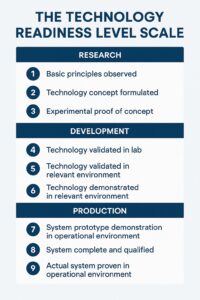Getting TRL Right: How Startups Can Win Early in the Bioeconomy
If you’re in the early stages of building a pilot plant in the bioenergy space, you’re likely managing a complex mix of technical goals, budget constraints, and regulatory compliance. One crucial element that often gets overlooked—yet can make or break your trajectory—is the Technology Readiness Level, or TRL.
Technology Readiness Level (TRL) assessments are not just a bureaucratic step. They’re essential tools for:
- Understanding the maturity of your innovation
- Communicating effectively with investors and stakeholders
- Aligning with funding requirements from government programs and private backers
“The earlier a startup integrates TRL planning into its development roadmap, the faster it can spot technical blind spots, meet funder expectations, and avoid expensive detours.”
Developed by NASA and adopted globally by organizations like the U.S. Department of Energy (DOE), Department of Defense (DOD), and European Commission, the TRL scale provides a standardized method to gauge technology maturity—from initial concept (TRL 1) through full commercialization (TRL 9).
Too many early-stage ventures treat TRL as a back-end compliance task. In reality, it’s a strategic tool that should be part of your planning from day one. A proactive TRL approach builds alignment across teams, sharpens decision-making, and opens doors to funding and partnerships.
At LEC Partners, we’ve guided hundreds of clients through TRL assessments in sectors like biofuels, bioplastics, fermentation, and pyrolysis. Our deep experience includes:
- DOE loan guarantee support
- Scale-up validation for private equity-backed firms
- Risk mitigation for institutional investors
With a community of engineers, scientists, and analysts averaging over 30 years of industry experience, we map out your technology’s progression with clarity and credibility.
What we offer:
- Clear benchmarking: Identify your actual TRL level and the criteria to progress.
- Custom roadmaps: Practical steps aligned to your technology and market.
- Budget and timeline accuracy: Estimates grounded in real-world experience (over $3B in evaluated projects).
- Investor and grant alignment: We speak the language of DOE, USDA, and institutional investors.
Case Insight: We recently evaluated a client’s activated carbon process for PFAS and H2S removal. Despite strong lab-scale results, we uncovered scale-up risks in six key operations. Our work helped structure a testing plan, fill documentation gaps, and recalibrate timelines—ultimately strengthening the client’s investor pitch.
Avoid the trap of guessing your readiness. A third-party TRL assessment delivers the proof investors and regulators expect.
Bioeconomy innovation is challenging, but getting TRL right gives you a strategic edge. If you’re serious about scaling confidently, let’s connect.
Have some questions?
Not sure where to start?
Let's start a conversation. We're here to help you navigate
the bioeconomy with confidence.

